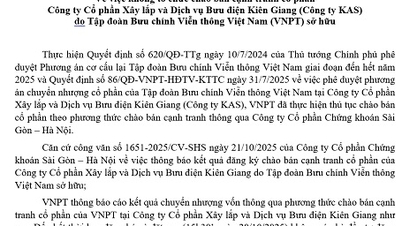Vietnam's labor productivity has continuously increased in both value and speed, thereby promoting growth and making important contributions to the country's socio -economic development, but is still far behind the world.
Fast improvement
Labor productivity at current prices increased from 70 million VND/worker in 2011 to 150.1 million VND/worker in 2020. Labor productivity in 2020 was 2.1 times higher than in 2011. During the period 2011-2020, Vietnam's labor productivity increased by an average of 8.9 million VND/worker per year.
According to the National Statistical Yearbook 2022 of the General Statistics Office, in 2021 - a year heavily affected by the Covid-19 pandemic, Vietnam's labor productivity increased dramatically from 150.1 million VND/worker in 2020 to 172.8 million VND/worker, 22.7 million VND/worker higher than in 2020; by 2022, labor productivity reached 188 million VND/worker, an increase of 15.2 million VND/worker compared to 2021.
According to the explanation of former General Director of the General Statistics Office Nguyen Bich Lam, the reason for the sudden increase in labor productivity in 2021 and 2022 was due to the unusual calculation technique of the General Statistics Office when excluding about 4.4 million workers who produce products for their own consumption in the fields of agriculture, forestry and fisheries.
Meanwhile, the value of products produced for self-consumption is calculated and included in the GDP scale to calculate the labor productivity of the economy. The number of self-producing and self-consuming workers currently accounts for about 8.2% of the working population of the economy.
The rate of labor productivity growth in the recent period of Vietnam's economy has improved significantly.
On average, in the 2011-2020 period, the labor productivity growth rate at current prices reached 5.29%; of which the average in the 2011-2015 period increased by 4.53%; the average in the 2016-2020 period increased by 6.05%, exceeding the target set in Resolution No. 05-NQ/TW, session XII, which is the average annual labor productivity growth rate in the 2016-2020 period higher than 5.5%.
In 2021, the labor productivity growth rate only reached 4.6% compared to 2020 (if including workers doing self-production and self-consumption jobs, it only increased by 2.9%) because Vietnam's economy was heavily affected by the Covid-19 pandemic, causing GDP growth in 2021 to only reach 2.56% while workers gradually returned to work after social distancing.
Although the economy achieved a high growth rate of 8.02% in 2022, its labor productivity only increased by 4.7% compared to the previous year. On average, in 2021-2022, labor productivity increased by 4.65% per year, which is quite low compared to the target of the socio-economic plan for the period 2021-2025 and the 10-year socio-economic development strategy for 2021-2030, which sets an average annual labor productivity growth rate of over 6.5%.
That means to achieve the 2021-2025 plan target, on average, labor productivity needs to increase by about 7.8% each year from 2023 to 2025. Thus, according to Mr. Lam, although there has been an improvement, labor productivity in recent years has increased relatively slowly and has not had the expected breakthrough.
This is a big challenge for Vietnam's economy because the country's development process shows that accelerating labor productivity growth is decisive for the economy's competitiveness, Mr. Nguyen Bich Lam assessed.
Still far behind the region and the world
In terms of purchasing power parity (PPP 2017), Vietnam's labor productivity in the 2011-2022 period increased by an average of 5.3% per year, higher than the average growth rate of Malaysia (1.4% per year); Thailand (1.9% per year); Singapore (2.2% per year); Indonesia (2.8% per year); Philippines (3% per year).
Thanks to that, Vietnam has narrowed the relative gap with countries in the ASEAN region with higher levels of development. If in 2011 the labor productivity of Singapore, Malaysia, Thailand, and Indonesia was 12.4 times; 4.3 times; 2.1 times and 1.7 times higher than that of Vietnam, then by 2022 this relative gap will decrease to 8.8 times; 2.8 times; 1.5 times and 1.3 times, respectively.
According to PPP 2017, Vietnam's labor productivity in 2022 will reach 20.4 thousand USD, only 11.4% of Singapore's labor productivity; 35.4% of Malaysia's; 64.8% of Thailand's; 79% of Indonesia's and 94.5% of the Philippines'; equivalent to Laos' labor productivity (20 thousand USD).
Compared with large-scale developed economies, Vietnam's labor productivity is equal to 15.4% of the US; 19.1% of France; 21.6% of the UK; 24.7% of South Korea; 26.3% of Japan and 59% of China.
Mr. Nguyen Bich Lam assessed that this reflects that Vietnam's economy is facing a huge challenge to catch up with the labor productivity of countries in the region and the world in the coming time.
Comparing productivity in terms of hours worked per worker employed (as GDP divided by total hours worked by workers in a year) gives a clearer picture of changes in labor productivity in the economy due to better control of underemployment that is widespread in many countries.
According to PPP 2017, Vietnam's labor productivity per working hour in 2021 only reached 10.2 USD, quite low compared to some countries in the ASEAN region. Specifically, Singapore reached 74.2 USD; Malaysia 25.6 USD; Thailand 15.1 USD; Indonesia 13 USD; equivalent to the Philippines' labor productivity per hour of 10.1 USD. In large-scale developed economies, the labor productivity per working hour of the US reached 70.7 USD; France 58.5 USD; UK 51.4 USD; South Korea 41.5 USD; Japan 39.6 USD; China 13.5 USD.

Vietnam's labor productivity has narrowed the gap with other countries in the ASEAN region with higher levels of development. Photo: Hoang Ha
New motivations are needed.
Our country's low labor productivity is due to: Unreasonable labor structure by economic sector; Failure to promote the leading role of intra-industry labor productivity; Low labor productivity of the enterprise sector; Limited application of technology and techniques in production and business, outdated machinery, equipment and technological processes; Inadequate human resources, unable to meet the requirements of improving labor productivity and promoting socio-economic development.
In the past 5 years, the world has experienced many events, with 4 characteristics: Unpredictable fluctuations; uncertainty; complexity and ambiguity. The events have led to strong changes in world economic activities, the global economic order has loosened; the values of economic liberalism have been seriously challenged; trade protectionism has returned. The global supply chain has been reshaped to be more flexible and adaptable.
To overcome economic shocks and address demographic labor shortages, countries have ramped up technology adoption, restructured their workforces, and reshaped global supply chains. These adoptions and adjustments have become drivers of productivity growth.
Mr. Lam recommended that, in order to keep pace with the irreversible changes in the world economy and to improve the competitiveness of the Vietnamese economy, the Government, ministries, branches, localities and the entire political system need to be imbued with awareness of the importance of labor productivity and urgently develop and implement the National Strategy on improving Vietnam's labor productivity.
Lan Anh
Vietnamnet.vn



![[Photo] President Luong Cuong receives US Secretary of War Pete Hegseth](https://vphoto.vietnam.vn/thumb/1200x675/vietnam/resource/IMAGE/2025/11/02/1762089839868_ndo_br_1-jpg.webp)

![[Photo] Lam Dong: Images of damage after a suspected lake burst in Tuy Phong](https://vphoto.vietnam.vn/thumb/1200x675/vietnam/resource/IMAGE/2025/11/02/1762078736805_8e7f5424f473782d2162-5118-jpg.webp)










































































































Comment (0)